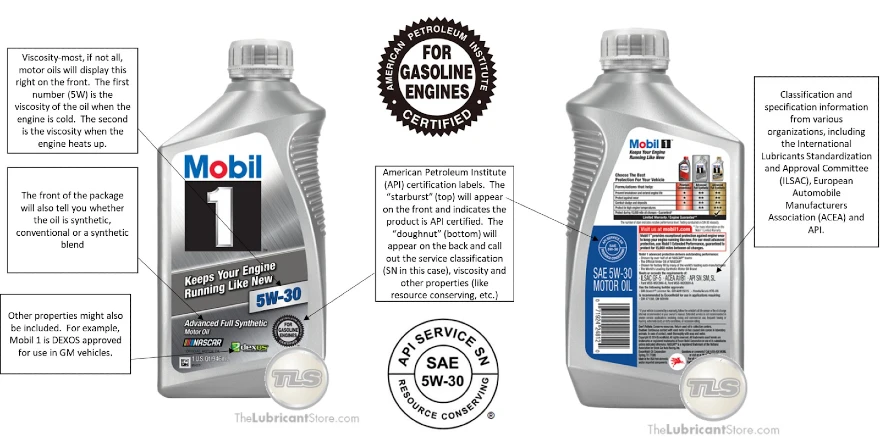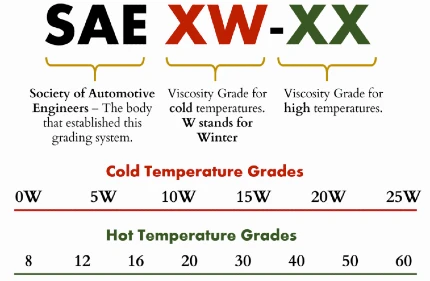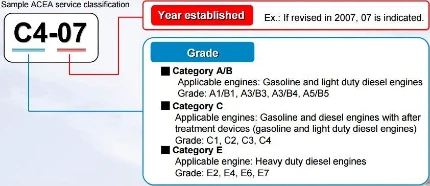Engine oil marking
Not knowing how to read the front and back label of the motor oil you buy can lead to poor performance or engine damage. The following are some key items to look for on motor oil labels and deciphering the labels to consider before buying.

The key to long and stable engine operation is to choose an oil that meets all the characteristics and requirements of the car manufacturer. The marking on the oil label contains all the information you need for the right choice, you just need to know how to decipher it.

In order to streamline and simplify the procedure of selecting oil for a particular type of engine according to the required characteristics and the tasks assigned to it, a number of international standards have been developed. The world oil manufacturers use these universally recognized classifications:
- SAE;
- API;
- ACEA;
- ILSAC.
There are 2 main classes of engine oils, depending on the type of engine: gasoline or diesel, although there is also a universal oil. Designation data is always specified on the label. Any engine oil consists of a base composition (mineral oil), which is its base, and certain additives. Therefore, according to the chemical composition are divided into:
- mineral;
- semi-synthetic;
- synthetic.
Such data is always specified along with other characteristics. What is indicated on the label:
- SAE viscosity grade.
- API, ACEA, ILSAC specifications.
- Automobile manufacturers' approvals.
- Barcode.
- Batch number and date of manufacture.
- Pseudo labeling (is not a recognized standard labeling, but is used as a marketing ploy, such as fully syntetic, HC, with the addition of smart molecules, etc.).
- Special categories of motor oils.

To help you buy the oil that will suit your car engine best, we will explain how to read the oil label correctly and decipher the most important markings.
What does the SAE engine oil marking mean?
The most important characteristic, which is indicated in the marking on the canister is the viscosity index according to the SAE classification (Society of Automotive Engineers) — an international standard, which regulates the viscosity of oils at plus and minus temperatures.

According to the SAE standard, the oil is denoted in the format XW-Y, where X and Y are certain numbers. The first number is a reference to the minimum temperature at which the oil can normally be pumped through the ducts and the engine can be cranked without difficulty. The letter W stands for the word Winter.
| Values | 0W | 5W | 10W | 15W | 20W | 25W |
|---|---|---|---|---|---|---|
| Turning | -30°С | -25°С | -20°С | -15°С | -10°С | -5°С |
| Pumpability | -40°С | -35°С | -30°С | -25°С | -20°С | -15°С |
The second number conventionally means the maximum value of the high-temperature viscosity limit of the oil when heated to the operating temperature (+100...+150 ° C). The higher the number, the thicker it remains when heated. To take the number as a literal indicator of resistance to ambient temperature is a misconception.
| 5W — 30 | from minus 25 to plus 20 |
| 5W — 40 | from minus 25 to plus 35 |
| 10W — 30 | from minus 20 to plus 30 |
| 10W — 40 | from minus 20 to plus 35 |
| 15W — 30 | from minus 15 to plus 35 |
| 15W — 40 | from minus 15 to plus 45 |
| 20W — 40 | from minus 10 to plus 45 |
| 20W — 50 | from minus 10 to plus 45 and higher |
| SAE 30 | from 0 to plus 45 |
Viscosity characteristics, are the first and most important element of the classification and labeling of motor oils, but not the only one — it is not right to choose an oil solely by its viscosity. It is always necessary to choose the right ratio of oil properties to its operating conditions.
Each oil besides viscosity has a different set of operational properties (detergent, antioxidant, antiwear properties, propensity to various sediments, corrosive activity and others). They allow determining the possible field of their application. And this information is coded in the API, ACEA and ILSAC labels.
What does the API designation on the label of the motor oil mean?
The API is a standard of the American Petroleum Institute established for the oil industry back in 1924. This engine oil label meaning determines what kind of engine oil is suitable for. In the API classification the main indicators are: engine type, engine run, oil performance, conditions of use.
What do the API letters mean?
The standard on the engine oil marking divides oils into two categories: gasoline and diesel. The letter «S» shows intended for gasoline engines. The «C» stands for those intended for diesel vehicles. Therefore, the API designation begins with the letter S or C, which will talk about the type of engine in which it can be filled. The next letter of the oil grade designation indicates the level of performance properties.
How to decipher the API marking?
According to the API, the deciphering of the marking of engine oils is as follows:
- the letter S (Service) denotes the use of oil for gasoline engines;
- the letter C (Commercial) designates oils for diesel engines;
- one of these letters is followed by the level of performance indicated by the letters from A (the lowest level) to P and beyond (the higher the alphabetical order of the second letter in the designation, the higher the oil grade);
- multi-purpose oils have the letters of both categories in a slash line (e.g.: API SL/CF);
- API marking for diesel engines (letter «C») is divided into two-stroke (number 2 at the end) and four-stroke (number 4).
At present, 6 classes of engine oils are relevant:
| Years of implementation | 1980 | 1989 | 1994 | 1997 | 2001 | 2004 | 2010 | 2020 |
| API oils for gasoline engines | SF | SG | SH | SJ | SL | SM | SN | SP |
| Years of implementation | 1983 | 1990 | 1994 | 1998 | 2004 | 2010 |
| API oils for diesel engines | CE | CF-4 | CF, CF-2, CG-4 | CH-4 | CI-4 | CJ-4 |
Those motor oils which have passed the API/SAE test and meet the requirements of the current quality categories and are licensed — are indicated on the labels by a circular graphic symbol. At the top there is the inscription — «API» (API Service), in the middle the degree of viscosity according to SAE, as well as the possible degree of energy saving.


What does ACEA classification mean?

The ACEA classification was developed by the European Automobile Manufacturers' Association. It specifies the performance, purpose and category of the engine oil. ACEA grades are also subdivided into diesel and gasoline, the same as the API.
The latest edition of the standard divides oils into 3 categories and 12 classes:
- A/B — gasoline and diesel engines for cars, vans, and vans (A1/B1-12, A3/B3-12, A3/B4-12, A5/B5-12);
- C — gasoline and diesel engines with catalytic converter (C1-12, C2-12, C3-12, C4-12)
- E — truck diesel engines (E4-12, E6-12, E7-12, E9-12).

What does the ILSAC marking on the motor oil label indicate?
ILSAC — a joint invention of Japan and America, the International Committee for Standardization and Approval of Motor Oils has issued 6 standards for motor oils: ILSAC GF-1, ILSAC GF-2, ILSAC GF-3, ILSAC GF-4, ILSAC GF-5 and GF-6. They are completely similar to the API grades, the only difference is that the oils corresponding to the ILSAC classification are energy-saving and multigrade. This classification is best suited for Japanese cars.
Conformity of ILSAC grades to API:
- GF-1 (obsolete) — meets the oil quality requirement similar to the API SH category; SAE 0W-XX, 5W-XX, 10W-XX viscosity, where XX-30, 40, 50,60.
- GF-2 — meets the oil quality requirements of API SJ, and viscosity requirements of SAE 0W-20, 5W-20.
- GF-3 — is analogue of API SL category and is introduced since 2001.
- ILSAC GF-4 and GF-5 are analogues of SM and SN respectively.
- ILSAC GF-6 — corresponds to the new SP standardization.
In addition, within the framework of ISLAC standard for Japanese cars with turbocharged diesel engines, JASO DX-1 class is used separately. This labeling of automotive oils provides engines of modern cars with high environmental friendliness parameters and built-in turbines.
Deciphering of approvals and vehicle manufacturer specifications
The API and ASEA classifications formulate the minimum basic requirements, which are agreed between oil and additive manufacturers and car manufacturers. Since engine designs vary from brand to brand, the oil conditions are not quite the same. Some major engine manufacturers have developed their own engine oil classification system, called tolerances, which complements the ACEA classification system.
Engine manufacturers such as: VW, Mercedes-Benz, Ford, Renault, BMW, GM, Porsche and Fiat, predominantly use their own approvals when selecting oil to fill the engine. The car's instruction manuals necessarily include the specifications, and their numbers are printed on the oil's packaging, next to the designation of its performance class.
Let's consider and decipher the most popular and frequently used approvals present in the designations on the canisters with engine oils.
VAG approvals for passenger cars
VW 500.00 is an energy-saving motor oil (SAE 5W-30, 10W-30, 5W-40, 10W-40 etc.), VW 501.01 is an all-season oil for conventional petrol engines produced before 2000 and VW 502.00 for turbocharged engines.
Approval VW 503.00 prescribes that this oil for gasoline engines with viscosity gauge SAE 0W-30 and extended drain interval (up to 30,000 km), and if the exhaust system with a three-component neutralizer, the engine of such car fill oil with the approval VW 504.00.
For VW, Audi and Skoda cars with diesel engines there is a group of oils with the tolerance VW 505.00 for TDI engines produced before 2000; VW 505.01 is recommended for PDE engines with pump-injector.
Energy-saving 0W-30 viscosity grade engine oil with VW 506.00 approval has a longer drain interval (for V6 TDI engines up to 30,000 km, 4-cylinder TDI engines up to 50,000 km). Recommended for new generation diesel engines (after 2002 model year). For turbocharged engines and PD-TDI pump injectors it is recommended to use oil with the tolerance VW 506.01 with the same extended drain interval.
Tolerances for Mercedes cars
Car manufacturer Mercedes-Benz also has its own approvals. For example, the engine oil with the designation MB 229.1 is designed for diesel and gasoline engines of Mercedes models produced since 1997. The MB 229.31 approval was implemented later and corresponds to the SAE 0W-, SAE 5W- specification with additional requirements that limit the sulfur and phosphorus content. MB 229.5 is an energy-saving oil with an extended service life for both diesel and gasoline engines.
BMW motor oil approvals
For engines manufactured in late 2001, we recommend BMW Longlife-01 approved oil. The BMW Longlife-01 FE specification stipulates that the oil should be used in heavy-duty applications. BMW Longlife-04 is approved for use in modern BMW engines.
Engine oil approvals for Renault
Renault RN0700 approval was introduced in 2007 and meets the basic requirements: ACEA A3/B4 or ACEA A5/B5. Renault RN0710 meets ACEA A3/B4 and Renault RN 0720 meets ACEA C3 plus additional Renault requirements. The RN0720 tolerance is designed for use in the latest generation diesel engines with diesel particulate filters.
Tolerance for Ford vehicles
This SAE 5W-30 engine oil with Ford WSS-M2C913-A approval is intended for initial and service replacement. This oil meets ILSAC GF-2, ACEA A1-98 and B1-98 classification and additional Ford requirements.
Ford approved oil M2C913-B is intended for initial fill or service replacement in gasoline and diesel engines. Also meets all ILSAC GF-2 and GF-3, ACEA A1-98 and B1-98 requirements.Ford WSS-M2C913-D was introduced in 2012 and is recommended for all Ford diesel engines except Ford Ka TDCi models produced before 2009 and engines produced between 2000 and 2006. Allows for extended drain intervals and is fueled with bio-diesel or high sulfur fuels.
Ford WSS-M2C934-A approved to extend drain intervals and is intended for use in diesel-powered cars with diesel particulate filters (DPF). Ford Specification WSS-M2C948-B is based on ACEA Class C2 (for gasoline and diesel engines with a catalytic converter). This approval requires an oil with a viscosity grade of 5W-20 and reduced soot generation.
FAQ:
-
What symbol identifies that the motor oil meets Ilsac standards?
API «Starburst» signifies that the oils meet the latest (ILSAC) standards, designated ILSAC GF-6A.
-
What is 5w 30 engine oil?
5w30 is a multi-grade oil, it ranges from a lower viscosity of 5 to a higher grade of 30. 5w30 is a motor oil, used in light-duty gasoline and diesel engines.
 High engine oil consumption
High engine oil consumption
 Oil for a diesel
Oil for a diesel
 Why is dashboard oil light on
Why is dashboard oil light on
 Why does engine oil eventually turn black
Why does engine oil eventually turn black
 How often should you change the oil
How often should you change the oil
 Motor oil test
Motor oil test